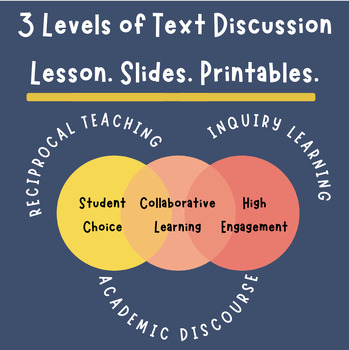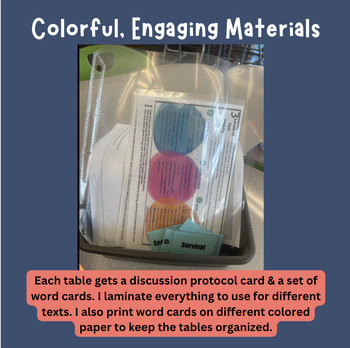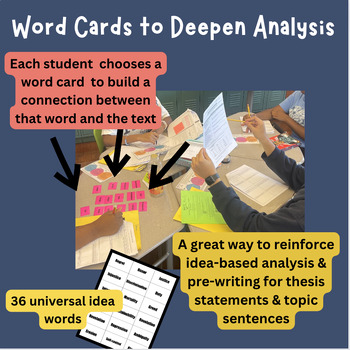3 Levels of Text Discussion: Text-based analysis, discourse, lesson, slides
- Zip
Description
Searching for a way to push students towards idea-based, evidence-based thinking instead of plot summary? This is it! The 3 Levels of Text Discussion is inquiry-based, facilitating higher levels of DoK in task and academic discourse.
Adaptable across disciplines (works equally as well in History as ELA!) and grade levels (middle-high school, including AP Language and Literature), this activity is rooted in evidence-based claims, analytical thinking, and collaborative learning.
The 3 Levels of Text is a structured discussion protocol grounded in reciprocal teaching, engaging students across text-to-self, text-to-community, and text-to-world thinking WHILE providing a structure for idea-based thinking.
With "Word Cards," students practice grounding their thinking about text in universal ideas, rather than plot summary. Each student either chooses a word card intentionally or randomly (random makes it more challenging!). Each word card is a universal idea, or abstract noun -- the number 1 way to flip a student's thinking from plot to evidence-based ideas and deeper analysis. Students are challenged to connect their word cards to specific evidence in the text, answering HOW and WHY the word is related to text through theme/message, characterization, etc. A twist on "word cards" to gamify the discussion: a team member displays a word card, and the first person to connect it to the text with specific evidence/moment from the text gets a point.
As each student works through the "3 levels" of discussion, team members take notes and plan for probing questions to push the discussion/accountable talk using the note taker. The structure of the discussion allows for building on each other's ideas, as well as practice in listening / note taking to capture points of agreement and disagreement.
I've used this in so many iterations from 8th-12th grade. Students love the manipulatives -- great for tactile learning -- and I print in color and laminate both the discussion cards and word cards for future use across different texts. I use this as a formative and summative. It's fantastic for pre-writing as it allows students to practice for thesis statement and topic sentence development. Students walk away with many options for thesis statements after making evidence-based claims in their connection to the word cards.
This activity is a great structure for reciprocal teaching groups!
What's inside?
- 15 Colorful slides (PPT and PDF).
- Criteria for Success & Grading Rubric with discussion look for's
- Graphic Organizer Note Taker handout with a space for questions, points of agreement/disagreement and main ideas shared by team members
- Discussion Prep Pre-writing Questions (on slides & as a handout)
- Discussion Prep Pre-writing "Deep Dive" prompts (on slides & as a handout)
- 36 universal idea word cards
- Printable Discussion Protocol Card (looks great in color and laminated!)
Thank you for engaging with this resource!
Earn free TPT Credit!! Offer feedback by:
- Going to your "My Purchases" page to find the "Provide Feedback" button next to each purchase. Follow the link to offer a rating and leave a comment for the product.
- Each time you give Feedback, TPT awards you credit that you can use to lower the cost of future purchases.
- I value your feedback. I am continually improving and developing new resources based on feedback from the TPT community. Thank you!
Follow me by clicking the GREEN Star under my store name. Be the first to know about new products and promotions.
Check out these discourse resources to level up engagement in your classroom:
- Probing Questions Speed Dating
- Discourse Builder Discussion Roundtable / Close Reading Activity
- Questions Stems by Question Type One-pager
- Progressive Questioning PD Workshop
Check out these resources to engage students in Debate:
- Freedom v. Safety Debate
- Growth Mindset Debate
- Who Gets the Heart Debate
- Debate Template/Slides for In-person & Digital Debates
- Full Debate Bundle Adaptable for all levels/grades + ESL
Check out these Argument Writing Resources:
- AP Language Argument Essay Step-by-Step Writing Guide
- Rhetorical Claims & Appeals Bundle
- Argument Essay Slides
- Ethos, Pathos, Logos Slides
- AP Language Exam Overview & Study Guide with Links
- Argumentative Writing Folder
- Argument Writing Stems Handout with Counter-rebuttals
- “Unknown” AP Lang Argument Prompt Essay Organizer Kit
- “Overrated AP Lang Argument Prompt Essay Organizer Kit + Line of Reasoning
Check out these listings to boost your students’ engagement with Rhetorical Analysis
Read Like a Writer - Rhetorical Analysis Kit
AP Lang Rhetorical Analysis Essay Reflection Tool
Rhetorical Device BIG Slide Deck
Rhetorical Claims & Appeals Bundle
Preparing your students for AP / SAT Multiple Choice Exams? Drive home strategies through these resources that get students ENGAGED with test preparation.
- Multiple Choice READING Questions Video Guide + Scaffolded Notes
- Multiple Choice WRITING Questions Video Guide + Scaffolded Notes
- AP Lang Multiple Choice EXPERT LESSON Group Activity
- Multiple Choice WRITING Slides: Sentence Combining & Organization Questions
- Multiple Choice Strategies POWERPOINT - AP/SAT/PSAT/MCAS all subjects
- AP Lang Multiple Choice WRITING questions with VIDEO tutorials
- Multiple Choice READING questions GROUP SOLVE activity (AP Lang/SAT/PSAT)
- Multiple Choice Strategy Mini Cards





